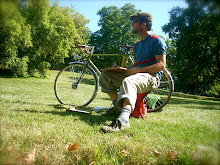Beginning in the waning days of spring 2010, I began work on a series of paintings to be hung this fall at Katie Gingrass Gallery. The work is part of a group show entitled Urbane: Portrait of a City. I suppose my inclusion makes a good amount of sense as I have been making drawings around the city for a number of years now. The current shift in my process has been venturing out loaded to paint. As a set-up it requires a bit more than works on paper. I have an old hiker's frame that I use to carry my french easel, complete with pigments and brushes. In the pannier baskets I carry my medium, a can with solvent for clean up, rags, and some snacks. Its cumbersome nature was an initial factor in keeping me closer to home for this work. All of my locations were within a couple of miles from where I live, on the near west side of Milwaukee. Working off the side of the bike also dictated the scale as it does with works on paper. Perhaps, there is a cargo bike in my future, should I choose to scale up?
In the early stages of the work, while scouting and drawing, the panels were strapped to the gear on the hiker's frame. It wasn't until the painting began in earnest that I installed the panniers.

location: Washington Park Lagoon 2

The short film at the heading of this post was shot on location in Washington Park and was the site of the second of two paintings along the Lagoon. Since 2005, I have made numerous monotypes that are loosely based on memories of a shoreline. Over the prior winter, I completed a suite of those prints and with several of the "ghosts" I developed painterly images working on top of the prints with Sennelier oil pastels. Though these works on paper are all inventions relying on memory of past observation, they seem to have acted as a genesis for this summer's painting, which was made exclusively and faithfully from observation.

Washington Park Lagoon 2: underdrawing

...with imprimatura applied

...following the first session of painting

...at work during the final session of painting

...detail from Washington Park Lagoon 2
In recent years I have cultivated a special relationship with this park. In part because it is close to home, and life with small children requires park time. There is also a certain quality that this particular space has that is difficult to pinpoint or describe. Maybe it is some echo of its grand past? Afterall, it is one of the flagship spaces in Frederick Law Olmsted's "Grand Necklace of Parks" designed for the Milwaukee area in the latter part of the 19th century. Formerly known as the West Park Zoological Gardens. It is positioned in such a way that it is bordered by neighborhoods that run the gamut of social and economic strata. To the east and some degree the north, you find some of the deepest poverty in the city. to the south you find a more entrenhced middle and working class. And to the west you find an avenue lined with wonderful stately homes one of which is the the domicile of our current Mayor. All of this means that the park ends up being utilized by a very demographically rich group of people as they comingle, excercise, play or perhaps find respite before returning to their life circumstances.

location: Washington Park Lagoon 1


...at the end of the first session of drawing

...underdrawing with imprimatura applied

...after the first session of painting

...after the second session of painting
During the early part of this past decade I spent time teaching on the college level. On more than one occasion I found myself speaking to how often one's process and even life trajectory may be cyclical in a way that is akin to a telephone cord (for those of you that can remember phones of a bygone telecom era). The cord does travel forward, but it constantly circles as it coils. Metaphorically, one may find their own work mimicking such a path. As you progress you simultaneously cross your prior path, mining your past as you move ahead.
One of my earliest, outside of school, art program experiences was taking part in a summer camp run by Fred Silver called Art Street Studio, in the early 1980's. The first year I signed up the program was held in Washington Park and was based in a commons building (which is now home to the Urban Ecology Center of Milwaukee, west campus). This is an area that is very close to the location of these paintings. In the program, there was a theatre troupe that would roam the park exploring experimental and improvisational modes of expression. The Milwaukee music legend, Berkley Fudge, ran a camp for jazz musicians. The sculptor Tom Queoff headed out the sculpture program and finally there was a 2-dimensional program, which is where I landed. back then it could be pretty rough in the park and we only lasted a few weeks before relocating to Lake Park (another Olmsted designed space). It's fascinating to me that after a quarter century I have returned and continue to utilize this park as a source for my artistic endeavours. What may be even more intersting is that during this summer's work I had more than one wonderful and slightly educational conversation with curious kids wondering how & what I was doing. Only now I was in the role of mentor.



















